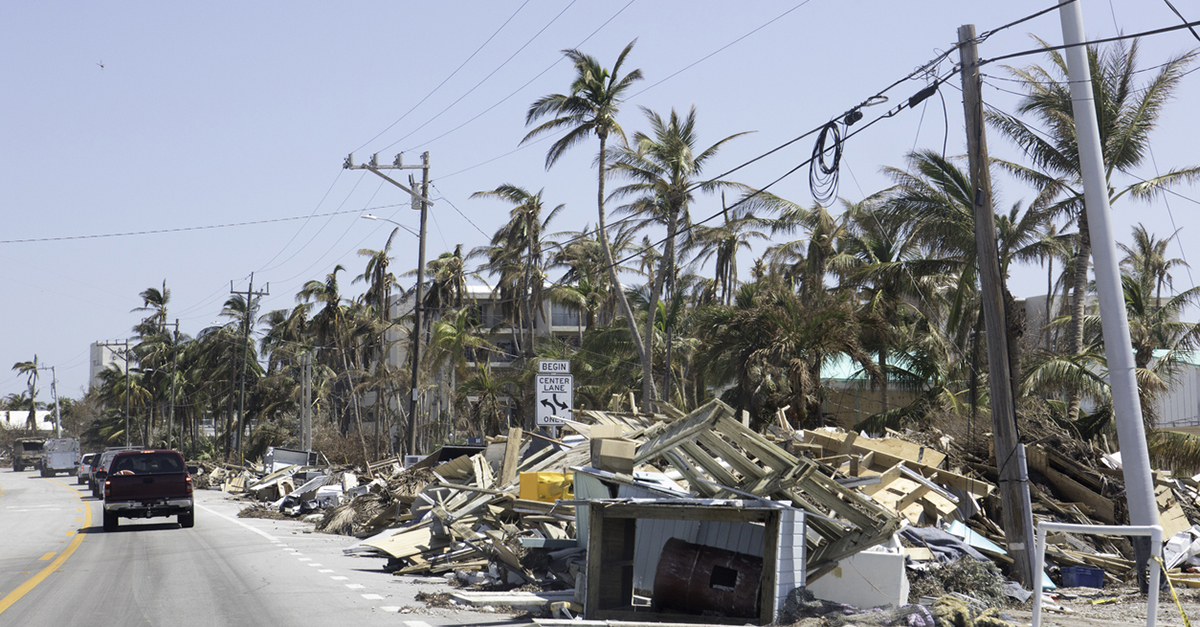Hurricane Michael—a Category 4 mammoth storm and the first of its strength to hit the Florida Gulf Coast with such force since 1851, when recordkeeping began—swept through the Florida Panhandle on October 10 with winds over 155 mph, leaving Mexico Beach in piles of rubble and claiming the lives of at least 18 people, as well as destroying and damaging structures across seven states (at press time).
At least 1.4 million homes were without power following the storm, as search and rescue efforts continue. According to CoreLogic early predictions, 57,000 homes were at risk from Hurricane Michael’s damaging winds and deadly storm surge, for which the reconstruction cost value could amass to $13.4 billion in a 100-percent destruction scenario.
The damage to date? Over 19,000 individuals and households have registered for disaster assistance, according to the Federal Emergency Management Agency (FEMA), and, according to CoreLogic’s post-landfall data, an estimated $2 billion to $3 billion in wind-related losses for residential and commercial properties in Florida, with storm surge accounting for approximately half a billion to $1 billion in losses (including those covered by the National Flood Insurance Program). In other impacted the states, the combined total losses caused by both wind and storm surge is expected to be around half a billion to $1 billion. Yardi Matrix predicts about 205,000 multifamily units in Florida, Georgia, South Carolina, North Carolina and Virginia may have been impacted by the hurricane.
Total damages are between $16 billion and $20 billion, Moody’s Analytics estimates. In terms of insurance, the Wall Street Journal reports that Florida is a unique environment in which most property damages will be paid by small, unfamiliar insurers backed by larger reinsurance companies from around the world, instead of the typical household names such as State Farm and Allstate. Experts estimate insured losses may range from $2 billion to $10 billion.
According to ClosingCorp, a provider of closing cost data, Hurricane Michael has endangered over 1,600 pending mortgage transactions with a combined value of more than $400 million. As for existing mortgages, homeowners impacted by the storm may be able to claim financial relief. As the hurricane neared, both Freddie Mac and Fannie Mae enacted disaster relief policies in locations that were presidentially-declared as Major Disaster Areas.
“Once safe from this dangerous storm, we strongly encourage homeowners whose homes or places of employment have been impacted by Hurricane Michael to call their mortgage servicer—the company to which borrowers send their monthly mortgage payments—to learn about available relief options,” said Yvette Gilmore, Freddie Mac’s vice president of Single-Family Servicer Performance Management, in a statement.
Those impacted by Hurricane Michael may be able to leverage Freddie Mac’s short-term forbearance programs if FEMA assistance is unavailable for immediate mortgage relief. Freddie Mac’s disaster relief policies include:
- Forbearance for up to 12 months, suspending foreclosures
- Late fees or penalty assessments waived for disaster-damaged homes
- Delays in reporting forbearance or delinquencies caused by the disaster to the nation’s credit bureaus
“Fannie Mae and our lending and servicing partners are focused on ensuring assistance is offered to individuals and families in need,” said Carlos Perez, senior vice president and chief credit officer at Fannie Mae, in a statement. “We also are focused on working with our Multifamily DUS® lenders and borrowers to determine appropriate actions to assist renters impacted by the storm. We urge everyone in the area to be safe, and we encourage homeowners affected by the storm to contact their mortgage servicer for assistance as soon as possible.”
Fannie Mae’s disaster relief policies include:
- Delays in mortgage payments for up to 12 months (no late fees or delinquencies reported during this time)
- Immediately suspended or reduced homeowners’ mortgage payments for up to 90 days if they believe the homeowner was impacted by disaster and has not contacted the servicer
- Payment forbearance of up to 12 months
- Suspended foreclosure and other legal proceedings if servicers believe homeowner was impacted by disaster
Hurricane Michael’s devastating blow came just a month after Hurricane Florence, a Category 4, slow-moving storm that drenched the Carolinas and Virginia. According to Porch, a home improvement marketplace, homes in these regions sustained an average of $2,919 in damages per home, totaling a whopping $180,978,000 in overall damages.
Since then, there’s been an uptick in several repair and home improvement fronts:
- Compared to 2017, drywall and plastering project requests were 15 times greater.
- Requests for flooring repairs increased tenfold.
- In comparison to 2017, roofing requests skyrocketed, at 23 times greater.
- Window projects and home-building are five times higher than in 2017 at this time.
“Wind causes obvious damage to the exteriors of homes, but once water is inside a home, the remediation process is extensive and expensive, and the damage isn’t always as obvious,” says Kyle Sandburg, Porch vice president of Strategy and Research. “Looking at the area Florence impacted, homeowners are already hard at work to remove flooring, rip out drywall, and generally deal with water removal and restoration, in addition to tackling exterior fixes like roofing, siding and window repair.”
While residents are still reeling from September’s destructive blow, these regions were once again impacted—Hurricane Michael, although downgraded from its initial strength to a tropical storm, wreaked havoc, causing the deaths of at least six individuals in Virginia alone, spawning several tornadoes and dumping 7 additional inches of rain in North Carolina this past week.
 Liz Dominguez is RISMedia’s associate content editor. Email her your real estate news ideas at ldominguez@rismedia.com. For the latest real estate news and trends, bookmark RISMedia.com.
Liz Dominguez is RISMedia’s associate content editor. Email her your real estate news ideas at ldominguez@rismedia.com. For the latest real estate news and trends, bookmark RISMedia.com.











